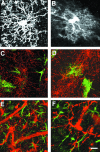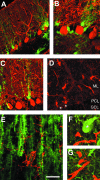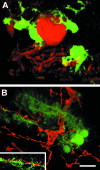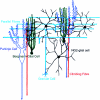Morphological and physiological interactions of NG2-glia with astrocytes and neurons
- PMID: 17459143
- PMCID: PMC2375760
- DOI: 10.1111/j.1469-7580.2007.00729.x
Morphological and physiological interactions of NG2-glia with astrocytes and neurons
Abstract
Models of central nervous system (CNS) function have historically been based on neurons and their synaptic contacts - the neuronal doctrine. This doctrine envisages glia as passive supportive cells. However, electrophysiological and imaging studies in brain slices show us that astrocytes, the most numerous cells in the brain, express a wide range of neurotransmitter receptors that are activated in response to synaptic activity. Furthermore, astrocytes communicate via calcium signals that are propagated over long distances by the release of 'gliotransmitters', the most abundant being adenosine triphosphate (ATP). This has led to the concept of the neuron-astroglial functional unit as the substrate of integration in the CNS. Recently, a novel glial cell type has been characterized by expression of the proteoglycan NG2. These NG2-glia receive presynaptic input from neurons and responds to neurotransmitters released at synapses. Now, studies on transgenic mice in which fluorescent proteins are specifically expressed by subclasses of glia are helping to address the question of where NG2-glia fit in the neuron-astroglial model of integrated brain function. NG2-glia, as well as astrocytes, have been shown to respond to neuronal and astroglial signals by raised intracellular calcium, which is a potential communications mechanism by which NG2-glia may be active partners in neuron-glial circuits. Moreover, a current concept of NG2-glia considers them to be 'neural stem cells' and an exciting prospect is that neuron-glial signalling may regulate the differentiation capacity of NG2-glia and their response to injury.
Figures






Similar articles
-
Integration of NG2-glia (synantocytes) into the neuroglial network.Neuron Glia Biol. 2009 May;5(1-2):21-8. doi: 10.1017/S1740925X09990329. Epub 2009 Sep 29. Neuron Glia Biol. 2009. PMID: 19785922 Review.
-
Astrocytes and NG2-glia: what's in a name?J Anat. 2005 Dec;207(6):687-93. doi: 10.1111/j.1469-7580.2005.00489.x. J Anat. 2005. PMID: 16367796 Free PMC article. Review.
-
Synantocytes: the fifth element.J Anat. 2005 Dec;207(6):695-706. doi: 10.1111/j.1469-7580.2005.00458.x. J Anat. 2005. PMID: 16367797 Free PMC article. Review.
-
Axons and astrocytes release ATP and glutamate to evoke calcium signals in NG2-glia.Glia. 2010 Jan 1;58(1):66-79. doi: 10.1002/glia.20902. Glia. 2010. PMID: 19533604
-
NG2-glia, More Than Progenitor Cells.Adv Exp Med Biol. 2016;949:27-45. doi: 10.1007/978-3-319-40764-7_2. Adv Exp Med Biol. 2016. PMID: 27714683 Review.
Cited by
-
Morphology and topography of retinal pericytes in the living mouse retina using in vivo adaptive optics imaging and ex vivo characterization.Invest Ophthalmol Vis Sci. 2013 Dec 19;54(13):8237-50. doi: 10.1167/iovs.13-12581. Invest Ophthalmol Vis Sci. 2013. PMID: 24150762 Free PMC article.
-
Dividing glial cells maintain differentiated properties including complex morphology and functional synapses.Proc Natl Acad Sci U S A. 2009 Jan 6;106(1):328-33. doi: 10.1073/pnas.0811353106. Epub 2008 Dec 22. Proc Natl Acad Sci U S A. 2009. PMID: 19104058 Free PMC article.
-
Differential Effect of Caffeine Consumption on Diverse Brain Areas of Pregnant Rats.J Caffeine Res. 2012 Jun;2(2):90-98. doi: 10.1089/jcr.2012.0011. J Caffeine Res. 2012. PMID: 24761269 Free PMC article.
-
Neural Tissue Homeostasis and Repair Is Regulated via CS and DS Proteoglycan Motifs.Front Cell Dev Biol. 2021 Aug 2;9:696640. doi: 10.3389/fcell.2021.696640. eCollection 2021. Front Cell Dev Biol. 2021. PMID: 34409033 Free PMC article. Review.
-
NG2-glia and their functions in the central nervous system.Glia. 2015 Aug;63(8):1429-51. doi: 10.1002/glia.22859. Epub 2015 May 24. Glia. 2015. PMID: 26010717 Free PMC article. Review.
References
Publication types
MeSH terms
Substances
Grants and funding
LinkOut - more resources
Full Text Sources

